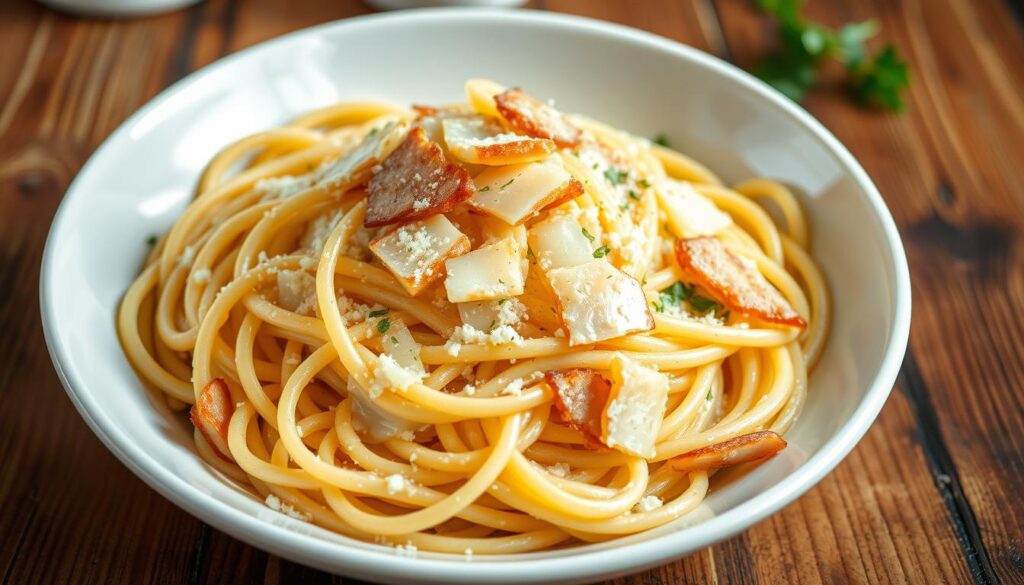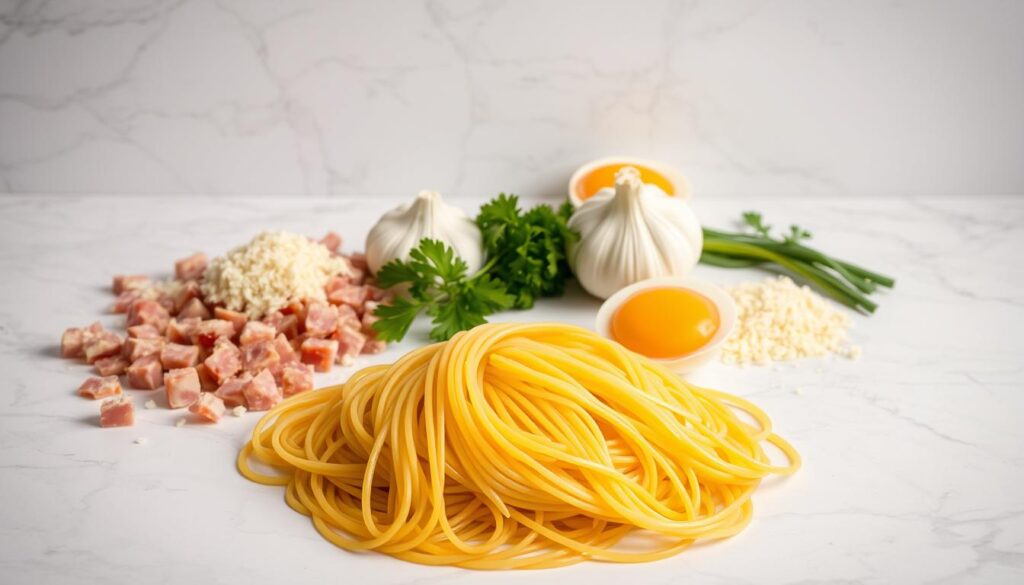My love for Spaghetti Carbonara started when I first tasted it in Rome. The sauce, made from eggs, cheese, and pancetta, felt like a family secret. Now, I’m sharing this authentic carbonara recipe with you. It’s the real deal, with no cream or shortcuts, just like it was in 1944.
This dish is more than just a recipe. It connects us to history and the beauty of simplicity.
Imagine al dente spaghetti in a creamy sauce. Each bite is a mix of smoky pancetta, sharp Pecorino, and fresh pepper. What makes it special? It’s the science behind it. Beaten yolks and pasta water mix to create a sauce that sticks to the noodles. It’s like magic, and you can make it at home with the right ingredients and patience.
Key Takeaways
- Traditional Spaghetti Carbonara avoids cream, using eggs and pasta water for creaminess.
- High-quality Parmesan or Pecorino creates the signature flavor.
- Cook pasta al dente, then mix with hot ingredients to prevent egg curdling.
- Guanciale or pancetta adds authentic smokiness without fatty excess.
- This 15-minute meal honors its 1944 origins with no compromises on tradition.
Introduction: My Journey to Perfect Spaghetti Carbonara
My love for pasta started with a bowl of traditional Italian carbonara in Rome. That first taste was creamy, savory, and full of flavor. It introduced me to the world of classic pasta dishes.
Years later, I’m still searching for that perfect balance. It’s a mix of simplicity and depth that makes it special.

The Inspiration Behind My Love for Pasta
Growing up near a family restaurant, I learned food is history. Carbonara’s story, tied to post-war Rome and carbone (charcoal), intrigued me. It showed me that tradition is about simplicity.
How I Discovered the Recipe
My big moment came when I studied Rome’s culinary history. I tasted versions from Trastevere’s nonnas. They taught me to mix eggs with hot pasta water, not cream.
Each ingredient had a role. Aged pecorino balanced the richness of raw yolks. Guanciale’s fat made the sauce.
Essential Ingredients and Must-Have Kitchen Tools
Every great carbonara starts with the right materials. Let’s explore what makes this dish shine, from the fresh ingredients for carbonara to the carbonara kitchen tools that simplify the process.

Choosing the Freshest Ingredients
Quality ingredients mean everything. Use fresh ingredients for carbonara like:
- Guanciale: Cured pork jowl adds authentic smokiness. Substitute with pancetta or bacon if unavailable.
- Pecorino Romano: Grate it yourself for maximum flavor. Pre-grated cheese dries out quickly.
- Eggs: Room-temperature eggs mix seamlessly into the sauce. Cold eggs can cause clumps.
| Ingredient | Key Quality | Substitute |
|---|---|---|
| Guanciale | Thinly sliced, fatty | Pancetta or thick-cut bacon |
| Parmigiano-Reggiano | Freshly grated | Pre-shredded cheese loses creaminess |
| Spaghetti | Al dente when cooked | Replace with rigatoni if preferred |
Tools That Make the Process Effortless
The right tools prevent mistakes. My must-haves include:
- Non-stick skillet: Prevents sticking while cooking guanciale.
- Microplane grater: Creates fine cheese shavings for a velvety texture.
- Wooden spoon: Non-reactive for mixing without scrambling eggs.
| Tool | Purpose | Example Brand |
|---|---|---|
| Microplane zester | Grates cheese quickly | Microplane Classic Grater |
| Large mixing bowl | Holds pasta and sauce evenly | Le Creuset stainless steel |
| Slotted spoon | Drains pasta without breaking strands | Cuisinart slotted spoon |
A wooden spoon prevents egg scrambling better than metal. Always use room-temperature eggs and avoid pre-shredded cheese. These details make all the difference!
Perfect Spaghetti Carbonara Technique for a Creamy Delight
Mastering the carbonara cooking technique is all about heat and timing. It’s what makes the creamy carbonara recipe so special. My way makes sure every bite is smooth and creamy, without any egginess.
Step-by-Step Cooking Process
- First, boil thick spaghetti in salted water until it’s just right. Save 1 cup of pasta water before you drain it.
- Then, cook crispy pancetta or guanciale until it’s golden. Set aside the fat and meat.
- Next, mix egg yolks, 1½ cups of Parmesan, black pepper, and ½ cup of half-and-half in a bowl. Don’t overmix it.
- Now, toss the hot pasta with the egg mixture in the pot, but keep it off the heat. Add pasta water a little at a time to loosen the sauce.
- After that, stir in the crispy pancetta and basil. Serve with extra Parmesan and pepper on top.
Maintaining the Authentic Flavors
The carbonara cooking technique requires patience. Let the pasta’s heat warm the sauce gently, without direct heat. For extra flavor, mix Parmesan with 30g pecorino romano for every 100g of pasta. Brown the pancetta in high heat, but keep the sauce warm.
Cooking Tips and Tricks for a Flawless Execution
Mastering carbonara tips means paying attention to small details. These details can make a big difference. Here’s what I’ve learned to ensure every bite is perfect:
- Temper Eggs Safely: Pull the pasta pot off the heat before mixing in the egg and cheese blend. Stir vigorously to emulsify the sauce without scrambling eggs.
- Guanciale’s Role: Opt for guanciale over pancetta for richer fat. Its cured pork cheek adds depth when crisped in the pan.
- Pasta Water Magic: Reserve ½ cup pasta water. Add it one tablespoon at a time to adjust sauce consistency, a pro move from Cook’s Illustrated methods.
Avoid these mistakes to stay on track: cooking tricks for carbonara demand precision. Never add cream—it dilutes tradition. Overcooking pasta? Test two minutes before the package time. And always mix cheeses: ⅔ Pecorino Romano and ⅓ Parmesan for balance.
- Use cold water to blend cheese and pepper into a smooth paste before mixing with eggs.
- Season aggressively with black pepper early; its flavor fades if added too late.
I’ve learned the best carbonara tips come from patience. Let the pasta rest 30 seconds after tossing with sauce to let flavors meld. And remember: the sauce thickens as it cools. Serve immediately to enjoy that velvety texture at its peak.
Plating and Presentation Ideas to Impress
Plating ideas for carbonara can make a meal unforgettable. Presentation pasta is not just about taste; it’s a feast for the eyes. Choosing the right plate and adding garnishes can make a big difference.
Start with a white plate to show off your dish’s richness. Fresh herbs like parsley or basil add color. A sprinkle of Parmesan cheese boosts both flavor and looks.
Creative Garnishing Techniques
- Layer ingredients: Place cheese and herbs on top of the pasta for depth.
- Add texture with crispy elements like fried onions or capers.
- Shave fresh truffles or drizzle truffle caviar for a luxurious touch.
- Use edible flowers or microgreens to contrast with the creamy sauce.
Serving Suggestions That Elevate the Dish
- Warm bowls enhance the dish’s aroma and texture.
- Leave empty space on the plate to keep the presentation clean and elegant.
- Pair with cold cuts like Parma ham folded into the pasta for added drama.
- Finish with a sprinkle of black pepper and a light drizzle of olive oil.
Simple yet thoughtful plating ideas for carbonara highlight the dish’s quality. Presentation pasta should mix creativity with tradition. This way, every bite is as appealing as it is delicious.
Avoiding Common Pitfalls in Recipe Preparation
Mastering carbonara means knowing what carbonara mistakes to avoid. Even small mistakes can mess up this delicate dish. Let’s look at the recipe preparation pitfalls that can ruin its taste and texture.
- Cold eggs = scrambled eggs in your sauce. Use room-temperature eggs to blend smoothly with pasta.
- Pre-grated cheese clumps. Freshly grated Pecorino Romano and Parmigiano ensures melt-in-your-mouth creaminess.
- Overheating the pan. Turn off heat before adding egg mixture—residual heat thickens the sauce, not direct flame.
- Adding garlic/onion. These overpower the egg-cheese base—stick to authentic ingredients like guanciale or pancetta.
- Skipping pasta water. A splash (¼ cup) emulsifies the sauce without thinning it.
Pro tip: Never whisk eggs in a hot pan. Toss cooked spaghetti directly into the egg mixture off-heat—this “emulsion trick” prevents scrambling. Avoid non-traditional add-ons like cream or basil; they drown the dish’s signature richness. Use dried spaghetti, not egg noodles, for better sauce adhesion. Always reserve pasta water as a rescue tool for thickening or thinning sauces.
Learning from these carbonara mistakes to avoid turns kitchen mishaps into mastery. Stay vigilant against recipe preparation pitfalls—your next carbonara will reward you with silky perfection every time.
Variations and Personal Twists to Transform the Recipe
Exploring carbonara variations opens a world of creativity. My journey taught me that even classic dishes thrive with personal touches. Start by swapping guanciale for pancetta or bacon—each adds a unique texture. For a lighter option, I’ve mixed in roasted mushrooms or zucchini, balancing earthy notes with creamy sauce.
- Indulgent upgrades: My “Carbonara of Dreams” blends egg yolks and pecorino for richness, while a dash of pasta water smooths the sauce.
- Technique tweaks: Chef Roberta’s method—cooking guanciale in a cold pan—releases natural fats, creating velvety creaminess without dairy.
- Seasonal twists: Fresh tomatoes or spinach add brightness, perfect for summer meals.
Personal recipe customization is key. I’ve tested egg-only bases for a modern twist or added garlic for depth. Always prioritize quality ingredients—golden yolks and aged pecorino make even small changes shine. Whether simplifying or elevating, every adjustment should honor the dish’s soul.
Serving and Pairing Suggestions for the Ultimate Meal
Make your Spaghetti Carbonara even better with serving suggestions for carbonara and pairing ideas pasta. I focus on balancing flavors and textures to ensure every bite is unforgettable.
Recommended Side Dishes
- Crisp Caesar salad for a tangy contrast
- Garlic bread to soak up the creamy sauce
- Roasted broccoli with lemon and garlic for brightness
- Caprese salad’s freshness cuts through richness
- Parmesan crisps add a salty crunch
Beverage Pairings That Compliment the Flavors
| Beverage | Pairing Notes | Serving Tips |
|---|---|---|
| Orvieto white wine | Acidity cuts creaminess | Chill slightly before serving |
| Pinot Grigio | Light citrus notes | Pair with garlic bread |
| Lemon sorbet | Refreshingly tart dessert option | Serve as a palate cleanser |
For pairing ideas pasta, grilled zucchini or green beans almondine are great. Keep the portions small so the carbonara can be the main attraction. Try these out and find your favorite pairing!
Conclusion
The traditional Italian recipe of carbonara remains timeless. It uses simple ingredients like guanciale, eggs, and Pecorino. This Roman dish shows that less is more.
Through years of practice, I’ve mastered the secret to its creamy texture. It’s all about mixing eggs right, not using heavy creams. This method has been passed down for generations.
Every bite of carbonara is a tribute to its origins. Yet, it also fits perfectly in today’s kitchens. It’s a dish that connects us to our past while enjoying the present.
Finishing touches are key to a great carbonara. Cooking pasta just right and tossing it gently ensures the sauce sticks well. This dish, born in post-war Rome, brings comfort and community to our tables.
Adding parsley or serving it with bread keeps its essence intact. Pair it with a crisp white wine to enhance its flavors. This way, you’ll enjoy every bite even more.
I hope this guide encourages you to try making carbonara. Its history is filled with stories of resilience and shared meals. By cooking it, you’re keeping a tradition alive.
Let each dish remind you of the connection to our heritage. Buon appetito, and may your carbonara always taste like a slice of Italy!
FAQ
Can I use cream in my Spaghetti Carbonara?
No, traditional Spaghetti Carbonara doesn’t use cream. It gets its creamy texture from eggs and cheese. For a true taste, go with the classic method.
What type of cheese is best for making Carbonara?
Pecorino Romano and Parmigiano-Reggiano are the top cheeses for Carbonara. They each bring a special flavor that makes the dish better.
How can I make my Carbonara sauce creamy without cream?
Mix hot pasta with eggs and cheese. Stir quickly. The pasta’s heat will cook the eggs, making a creamy sauce.
What pasta is authentically used for Carbonara?
Spaghetti is the traditional pasta for Carbonara. But, fettuccine or bucatini can also add a nice twist.
How do I avoid scrambling the eggs in my sauce?
Temper the eggs by slowly adding hot pasta. Then, remove the pan from heat while mixing. This keeps the eggs from scrambling.
What are good side dishes to serve with Spaghetti Carbonara?
A light mixed salad or garlic bread are great with Carbonara. They balance the rich pasta without overpowering it.
What drinks pair well with Spaghetti Carbonara?
Try crisp white wines like Pinot Grigio or light Chardonnay. Soft drinks or sparkling water also complement the dish well.
Are there variations of Spaghetti Carbonara I can try?
Yes! You can add peas or mushrooms to your Carbonara. Just remember to keep the traditional elements for the best taste.
What kitchen tools do I need to make Spaghetti Carbonara?
You’ll need a good grater for cheese, a wooden spoon for mixing, and a colander for pasta. These tools make the dish easier to make.
How do I know if my Carbonara has turned out well?
Good Carbonara has a silky, creamy sauce that sticks to the pasta. The flavors should be rich and balanced, showing off the ingredients.
SEE MORE : Alabama Fire Cracker Recipe
